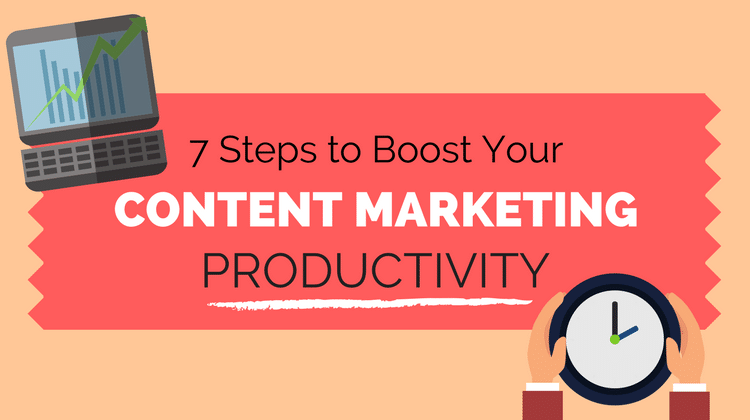
At this point, most small business owners know that content marketing can help their businesses. Ninety-four percent of small businesses are using content marketing to boost brand awareness, drive traffic, generate leads, and acquire customers. While content marketing has obvious benefits for your business, it can be a very time-consuming venture.
Small business owners have to wear a lot of hats, and if they spend too much time on content marketing, other aspects of their businesses may suffer. By increasing your content marketing productivity, you can free up the time to handle your other duties. Here are seven tips for boosting your content marketing productivity.
1. Brainstorm Ideas in Advance
One of the most time-consuming parts of content marketing is coming up with ideas for all that content. If you don’t know what you’re going to write about until you sit down at your computer, you could waste hours of valuable time. Before you start writing, you need to know exactly what you plan to write about.
To maximize your productivity, try to plan a few months’ worth of topics in advance. Set aside some time to brainstorm a long list of potential topics, and refer to it as needed. When you have a long list of potential topics to choose from, it’s easier to sit down and start writing.
2. Follow an Editorial Calendar
Knowing what you plan to write about is only part of the battle. You also need to know what type of content you’ll be creating, when you’ll be creating it, and when it will be posted. Without planning, you’ll find yourself scrambling at the last minute to plan your content, and you’ll end up wasting time.
Before you start writing any content, create an editorial calendar for your business. Your calendar lets you see at a glance what type of content you need to create, so you can get to work right away.
3. Store Your Research in One Place
Do you have hundreds of interesting websites bookmarked on your computer? That’s an inefficient way to manage your research process, as you’ve probably discovered. It takes a lot of time to find the site you’re looking for, and that time could be better spent creating content.
To keep your research organized, use a tool like Evernote. Evernote lets you clip articles from around the internet and store them in organized notebooks. Notebooks can be shared with others, so if you hire a writer to help create content, they can easily access the articles you’ve saved.
4. Streamline Your Workflows
Researching, outlining, drafting, and editing content can be a disorganized process. When you track your workflows on paper (or worse, in your head), you can forget key steps. Content can be delayed, or forgotten about entirely. This is a major drain on your productivity.
To become more productive, streamline your workflows with tools like Trello. With Trello, you can track each piece of content as it moves through your workflows. At a glance, you can see which content you’re researching, which content you’re drafting, and which content still needs to be edited. With organized workflows, you can spend more time writing, and less time trying to remember what needs to be done.
5. Automate Content Promotion
Once you’ve written your content, your work isn’t done. You have to promote your work to ensure it’s seen by your audience. Promotion isn’t an easy task, which is why 43 percent of small businesses spend six or more hours a week on social media. To become more productive, you need to learn to promote your content more quickly.
Automating your promotion tasks can help. Tools like Zapier or IFTTT can automatically post links to your latest blog posts on your social media accounts. If you want to promote each post multiple times, a tool like Edgar can help you automate those activities.
6. Track Content Metrics
A big drain on content marketing productivity is creating content that isn’t right for your audience. If your content isn’t data-driven, you could waste countless hours creating content that isn’t doing anything for your business. To become more productive, start tracking metrics for all of your content.
Metrics can let you know which content drives the most traffic, shares, and leads. You can also see which content is bringing the most revenue into your business. When you create your future content based on this data, you won’t be wasting time.
7. Re-Purpose Your Content
How long does it take you to write a blog post? Probably longer than you’d like. The average blog post now takes three hours to write. However, you don’t need to write every piece of content from scratch. Re-purposing your own content is a great way to get more value out of the work you’ve already done, and increase your productivity.
After you’ve written a few blog posts on similar subjects, you can combine them into an e-book. You can hire a designer to turn your blog posts into infographics. You can record your blog posts to create a podcast. The opportunities for re-purposing your posts are endless.
By boosting your content marketing productivity, you’ll have more time to focus on other aspects of your business. Do you have any tips for boosting content marketing productivity? Share them in the comments below.

That’s the trouble with content—it takes so long to do! (If you want to do it well, that is). For a freelancer like myself, finding the time to create and promote my own content (rather than my clients’ content) is tough. I think the first point about brainstorming ideas is the most important way to save time, at least in my case. Knowing what I am going to write as soon as I sit down speeds things up considerably.
Thanks for your comment, Jon. Coming up with ideas is the hardest part, for sure.